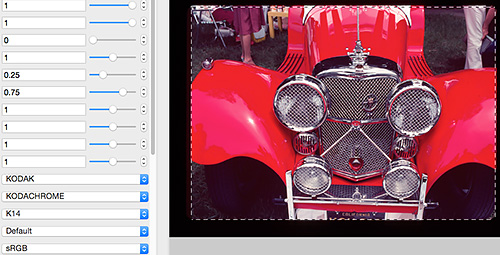Photo Corners headlinesarchivemikepasini.com
![]()
A S C R A P B O O K O F S O L U T I O N S F O R T H E P H O T O G R A P H E R
![]()
Enhancing the enjoyment of taking pictures with news that matters, features that entertain and images that delight. Published frequently.
Sneak Peak: OpticFilm 135 Kodachrome Scans




3 May 2016
When we profiled the OpticFilm 135, we used a target that was made from Ektachrome film. Kodak stopped making Kodachrome targets in 1999. Kodachrome scans are famous for a cool cast when scanned normally.

Chrome Grill. The final image derived from the VueScan scan.

Chrome Grill. The final image derived from the QuickScan Plus scan.
QuickScan Plus doesn't provide any special options for scanning Kodachrome. But VueScan does. The question we had was whether our Ektachrome ICC profile would enhance or detract from our scan of Kodachrome slides.
We simply enabled and disabled the ICC profile within VueScan to compare the two approaches:

We think the ICC profile does improve the results over the default, which is no profile.
That isn't a surprise, really. We aren't asking what Kodachrome looks like. We're asking what the scanner sees for certain known colors represented on an Ektachrome slide. So there may be unknown values on a Kodachrome scan but how the scanner deviates from known values won't be a mystery.
At the same time Plustek's QuickScan Plus, included with the scanner, received a minor update (bug fixes only), so we gave it a shot at the problem too. While we were generally disappointed (to put it mildly) with the results we got from QuickScan Plus, it did best with slides.
And except for a slight underexposure, which we noted previously and corrected with the QuickScan Plus Auto Enhance tool, it did well (as you can see above). You can see in the darker red paint that the scan is slightly bluer than it should be.
Of course, you're looking at an sRGB color space on the Web, which does not display as many blue-greens as, say, the ProPhoto color space VueScan used for this scan. And having 16-bit channels on the VueScan image gave us a lot more room to play around in than the 8-bit channels of the QuickScan Plus JPEG.
We'll save our analysis for the full review but we don't mind sharing our preliminary conclusions here.